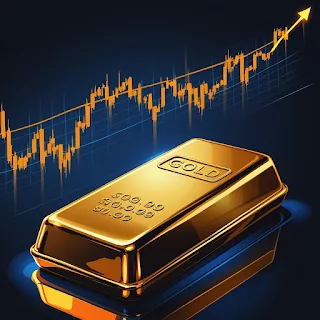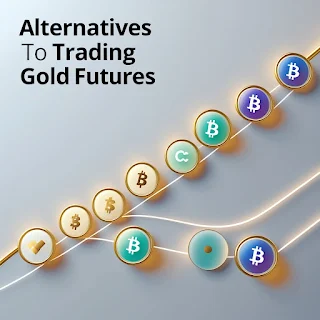Gold Futures: Unpacking the Influence of Paper Gold in 2025
Gold Futures: Unpacking the Influence of Paper Gold in 2025
Paper gold drives prices and investor moves in 2025.

Gold has always represented more than just a shiny metal. It stands as a beacon of security, a safeguard against turmoil, and in 2025, it’s once again taking the spotlight in global financial discussions. Among the various ways to invest in gold, one of the most strategic and impactful methods is through gold futures.
Now, I know what you might be thinking—this sounds a bit technical or even daunting. But fear not! Gold futures are actually one of the most potent tools in a modern investor's arsenal, especially in a market landscape marked by soaring inflation, geopolitical strife, and increasing uncertainty about what the Federal Reserve will do next. This blog is here to walk you through everything you need to know about gold futures: how they function, why they’re significant, and how they’re shaping economic strategies in the United States today.
What Are Gold Futures?
At their essence, gold futures are legally binding contracts to buy or sell a specific amount of gold at a set price on a future date. These contracts are mainly traded on major exchanges like the COMEX division of the CME Group. While some might picture vaults brimming with gold bars changing hands, the reality is much more digital than physical. Most contracts don’t end with actual gold delivery; instead, they’re typically settled for cash before they expire, with traders either pocketing the profit or taking a hit on the loss.
In short, gold futures allow you to tap into the price fluctuations of gold without the hassle of buying, storing, or securing any physical metal. This makes them quicker, more adaptable, and significantly more scalable than traditional gold investing.
Why Consider Trading Gold Futures?
Gold futures are a go-to for both investors and institutions, primarily for two reasons: hedging and speculation. For instance, gold mining companies often use these futures to secure prices for their product well in advance, shielding themselves from market fluctuations that could eat into their profits. On the flip side, investors leverage these same contracts to make predictions about gold's future price movements.
If you think gold's value is going to rise, you might purchase a futures contract today with the intention of selling it later at a higher price. If your prediction holds true, you’ll benefit from the price difference. However, if you’re mistaken, the losses can be quite steep—especially since gold futures are leveraged, meaning even small price changes can lead to significant gains or losses.
Gold Futures in the 2025 Market Landscape
As we look at the financial landscape of 2025, gold has once again emerged as one of the most sought-after commodities. With inflation still running high, interest rates on the rise, and market volatility increasing, gold has reaffirmed its status as a safe haven. This time around, though, much of the excitement is happening in the realm of futures trading.
Recent economic data indicates that ongoing inflationary pressures are preventing the Federal Reserve from making aggressive cuts to interest rates. At the same time, global uncertainties—from conflicts in the Middle East to the tech rivalry between the U.S. and China—are driving investors toward assets that aren’t tied to any specific government or currency. This is where gold futures really come into play.
They provide quick access to market exposure, enabling traders to react within minutes—not days—to significant economic or political events. Plus, because they’re highly liquid, investors can jump in or out of large positions without causing major disruptions in the market.
How Do Gold Futures Work?
Gold futures let you trade on tomorrow’s price—today.

When you enter into a gold futures contract, you're essentially agreeing to receive 100 troy ounces of gold at a predetermined price on a specific date in the future. But here's the catch: most traders don’t actually take delivery of the gold—they usually close out their contracts before they expire.
It's crucial to know that you don’t have to fork over the entire value of the gold to get started. Instead, you only need to put down a margin, which is usually just a small percentage of the total contract value. This setup lets you control a significant position with relatively little cash, but it also increases your risk.
For instance, if gold is priced at $2,500 an ounce, a futures contract for 100 ounces would be worth $250,000. However, you might only need to deposit around $15,000 as margin to make that trade. If the price shifts by just $50, your unrealized profit or loss could already be $5,000. It’s definitely a high-stakes game.
Physical Gold vs. Gold Futures
A lot of investors find themselves debating whether to invest in physical gold or trade futures. The right choice really hinges on your investment goals.
If your aim is to safeguard your wealth and own a tangible asset that won’t disappear during a market downturn, physical gold has its perks. It’s straightforward, it’s real, and it doesn’t rely on middlemen.
On the flip side, if you’re looking to take advantage of short- or medium-term fluctuations in gold prices, futures contracts provide the speed, flexibility, and liquidity that physical gold simply can’t offer. You won’t have to deal with storage, insurance, or shipping hassles. Plus, you can buy or sell in just seconds from anywhere around the globe.
The Risks You Should Know
Gold futures can be a powerful tool, but they’re not for everyone. The main attraction—leverage—also comes with significant risks. Since you’re only putting down a small portion of the total contract value, even a slight drop in prices can trigger a margin call or force you to liquidate your position.
Moreover, gold futures are time-sensitive. Each contract has an expiration date, and if you’re not careful, you might find yourself needing to roll over into a new contract at a less favorable price or even take physical delivery of the gold.
It’s also easy to get swept up in short-term fluctuations, especially in today’s fast-paced news environment where geopolitical events and economic reports can cause price swings of 1% or more in just one day. Without a solid strategy, the same contract that could potentially double your investment might also lead to significant losses in your trading account.
Who Should Consider Gold Futures?
If you’re an experienced investor who’s comfortable with risk and on the lookout for high-reward opportunities, gold futures might be a great fit for your investment strategy. They’re also appealing to institutional investors, hedge funds, and traders who need to hedge other investments or want to quickly diversify their portfolios.
However, if you’re a long-term investor seeking a reliable store of value, you might find that other options like physical gold, gold ETFs, or gold-focused mutual funds provide a smoother investment experience.
Alternatives to Trading Gold Futures
From ETFs to gold stocks—explore easier ways to invest in gold.

You don’t have to jump straight into futures contracts to gain exposure to gold. There are simpler alternatives that can still offer you the benefits.
Gold ETFs, such as SPDR Gold Shares (GLD), track the price of gold and can be traded just like stocks. They’re backed by physical gold and don’t require margin accounts.
If you prefer stocks, consider investing in gold mining companies for indirect exposure. These stocks can provide leverage to gold prices, but they also come with their own set of risks, such as operational performance and geopolitical factors.
Gold options offer traders a unique way to speculate with limited risk, though they come with their own set of strategies and expiration rules.
For traditional investors, simply owning bullion or gold coins is still a reliable method to hold onto the metal for the long haul.
The Future of Gold Futures
As we approach the latter half of 2025, gold futures are anticipated to stay quite active. Analysts are forecasting strong demand driven by central bank purchases, a weaker dollar, and ongoing economic uncertainty.
If the Federal Reserve hints at any significant changes—whether that’s cutting rates or tightening further—gold prices could see some dramatic shifts. Futures traders who can predict these movements or respond swiftly might uncover some great opportunities.
Moreover, advancements in algorithmic trading and AI-driven forecasting tools are making futures markets more accessible than ever, even for individual investors.
Final Thoughts
Gold futures are not just a means to wager on gold prices; they reflect how the world perceives risk, security, and value. During times of economic upheaval or global instability, they become a central topic in financial discussions.
However, like any powerful tool, they demand understanding and respect. If you’re ready to dive into this fast-paced environment, equip yourself with knowledge, manage your risks, and stay vigilant. The potential rewards can be substantial, but so can the pitfalls.
Whether you’re a seasoned pro or just dipping your toes in, gold futures present an intriguing way to engage with one of the world’s most timeless and universal assets. In 2025, they’re not just relevant—they’re essential.



Comments
Post a Comment